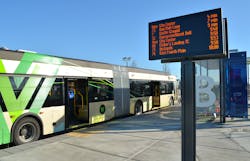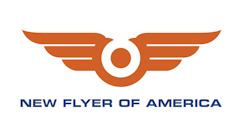Project Update: Vancouver Introduces First BRT-Light Line to the Area
C-Tran debuted the first bus rapid transit line (BRT), the Vine, to the Clark County area in Vancouver, Washington, in January of 2017. The BRT-light line was a project that was designed to reduce rider’s travel time and improve the reliability of C-Tran’s service in the area.
C-Tran made the decision to operate the BRT line as light; the Vine operates in mixed traffic and has signal priority.
“Anytime you dedicate a lane, the construction process is automatically more invasive, longer and more expensive. That obviously was one of the guiding principles behind why we chose to operate our BRT in mixed traffic,” explained Christine Selk, C-Tran communication and public affairs manager. “Just given project funding, resources and the scheduled standpoint, we felt that for our community and our ridership, mixed traffic was a more common-sense approach.”
Selk said that since introducing the Vine, C-Tran is getting closer to what its transportation goals are. “We have a more efficient journey along the corridor than had happened pre-BRT.”
By the Numbers
Opening date: January 8, 2017
Project cost: $53 million; 80% federal money, 6% state, and 14% local
Amenities: off-board fare collection, transit signal priority, wheelchair self-parking areas, on-board bike racks
Buses: 10 60-foot, low-floor hybrid buses
Stations: 34
Developing the Vine
WSP | Parsons Brinckerhoff was the project lead for the Vine. Stefano Viggiano, AICP, planning manager at WSP | Parsons Brinckerhoff, explained that the path to the Vine initially started with a high-capacity transit study that looked at a number of corridors in the area in 2008.
“That wasn’t really specific to the Vine project, but that study led to identifying this corridor. That first study was an alternative analysis to look at the content designs to the locally preferred alternative,” said Viggiano. “We did quite a bit of public outreach and got approval to of the project to get into project development.” Viggiano said that the actual work on the corridor started in 2011.
Once the project began Viggiano said that WSP | Parsons Brinckerhoff did community outreach on its own as a consultant, as well as working with another public outreach consultant. “C-Tran did quite a bit themselves and they did quite a bit of door-to-door work along the corridor; they went to businesses and talked to them. I think that was very helpful, that direct one-on-one contact to explain the project. A lot of times people have misconceptions about these types of projects and how they might impact them,” added Viggiano.
Selk said that C-Tran began doing outreach from the very start, hosting hundreds of meetings with the community, interest and stakeholder groups. “We met consistently with those groups who really are not only part of our core ridership group, but also members of the community who took a real strong interest in the project overall.”
Parkeon was responsible for ticket vending and transit priority signals, Pivot Architecture was selected as the station architect and Init Innovations in Transportation Inc. was responsible for passenger displays. New Flyer Industries Inc. created the expanded BRT buses.
Craig Runyon, marketing coordinator Pivot Architecture, said that C-Tran gave the company six words to describe what they wanted for the 33 different stations and stop designs: sleek, reliable, safe, freedom, user-friendly and community catalyst.
"We developed a response around these terms and really dug deep into what C-Tran wanted. We came up with five different concepts that C-Tran then narrowed down to three. Through some community engagement, C-Tran went out and essentially put the vote out to the public. Runyon explained that C-Tran put out a survey with the three concept ideas and presented it to the public. "C-Tran had their own idea of what they thought would be the No. one station, but the community overwhelmingly picked a different design." The ending design for the shelters and stations was called "Walking Sticks." The name references the collection of vertical elements supporting a simple roof. Runyon explained the "walking" columns reflect the speed of transit and the movement of people.
"The infill elements — benches, signage, public art and wind screens — can be modified to create a unique identity for each station. The shelter length, plus the amount and transparency of infill, can vary. Artwork and color can change to reflect the unique response to each neighborhood, yet stay unified in the Vine and C-Tran visual identity," said Runyon.
“The project cost $53 million,” said Selk. “There were three separate contracts for this project, one was obviously for the BRT corridor itself, but also we expanded our maintenance facility and we relocated our transit center.”
The Vancouver Mall transit center moved from one side to the other.
Viggiano said that the Vine project exhibited innovation. “I think some of the most innovative pieces were just the design, especially around Clark and College, and they incorporated the stations into the college. Another nice piece of the project was that we built a new transit center at the Vancouver mall. The platform has a covered walkway into the mall.”
Pivot designed the Vancouver Mall station to have six bays for fixed-route buses, two for the Vine buses and a driver relief building.
"It’s always new and innovative because the stations are custom designed so it makes it brand new,"said Runyon. "This (project) was custom in the fact that it listened to the owner and what the community wanted, developing a kind of community aimed response was important to that."
“We finished ahead of schedule and under budget,” Selk added.
Challenges with Developing a New System
Like many transit projects, there can be challenges that arise. Selk said that any new technology or transit option also comes with additional problems.
“I don’t think that any of these big capitol development projects operate in a vacuum. They are certainly full of challenges and this one was no different. I think that when you undertake a project of this size, first of all, not everyone is going to be on board with it,” said Selk.
Viggiano said that initially they had to address misconceptions about the project from the public’s standpoint, “on how it might impact them and how it might impact their property access. A lot of it was making them understand that they would be involved in the design decision as it moved forward and that nothing had been already determined.”
The corridor was originally planned to mesh with a light rail project that would come across the river from Portland, Oregon.
“They were going to share some of the downtown roadways — the light rail and the BRT. That project ended up being scrapped halfway through our plan and so we had to change our plan for the downtown area. When that project went away it actually changed some of the probably more innovative pieces of the BRT line,” said Viggiano.
Selk said that projects like the Vine don’t occur without a bit of “backlash” or differing opinions on how they should go. “You’re also constructing things in a really busy travel corridor, which is not going to be without challenge. When people feel that you’ve been out there longer than you need to be or ‘why am I not seeing people working every single station, every single day?’ I mean it’s to be understood, but to kind of translate and educate folks as to why their travel lane may be closed down for a couple days can be a challenge.”
“A lot of times people in the community think ‘oh you’ve already decided what you’re going to do and what I say doesn’t matter,’” explained Viggiano. “Overcoming that was a challenge I would say. The stakeholder committee that included a lot of people skeptical about the project eventually ended up supporting it.”
“It is an important responsibility of the agency to get that information out to folks,” said Selk. “I think that we did a good job of that, but people do get frustrated and they get annoyed by things like that. It is also a new system; it's brand new transit technology. So in addition to any sort of conveniences or different opinions that people might have had about it, there was a lot of education that went along with as to why their travel times were inconvenienced during construction.”
Benefits of the Line
Selk said that since the launch the line offers a number of benefits;
- Reduced travel times
- Improved trip reliability
- Reducing ongoing operations and maintenance costs compared to the cost of other service
- Increasing passenger capacity
- Improving safety and security
- Improving access to and from transit for pedestrians and bicyclists
“We’ve heard anecdotally on social media from riders that they have noticed time shaved off of their trip. It has been really great to see that posted in real-time; people are noticing time savings,” said Selk.
While the line first launched on January 8, the county was hit by a severe storm. C-Tran was forced to take the BRT buses out of rotation and put their 40-foot fixed-route buses back into service. Once the Vine was able to operate again, Selk said C-Tran has seen full buses with riders taking advantage of the line.
“There are a lot of people in my own department who ride the bus every day and they’ve been saying that they’re seeing a lot of folks riding the bus,” explained Selk. “We haven’t had the vehicles out long enough to take those measurements, but I’m really excited to do that.”
Along with attracting typical riders, the Vine is also attracting new riders. Selk explained that she doesn’t distinguish between choice and non-choice riders. Selk said that she feels all riders should be considered a choice-rider.
“But when you are trying to attract riders who normally don’t take the bus and they don’t have to take the bus, that is a great thing,” said Selk. “BRT systems, not only in North America, but all over the world, attract riders that might have not taken the bus before. I think that a lot goes into that, everything from the design of the station, the design of the vehicle itself, the ease at which riders can ride and the transit-oriented development that goes along with the BRT lines. I think that all of that adds up to attract a rider who maybe hasn’t considered taking a bus before and that is really exciting.”
C-Tran Reaping the Savings
“I think that the most exciting thing about BRT from C-Tran’s perspective is, I think something that we share with other transit agencies,” said Selk, “it’s the savings that you get from time and fuel savings. All of those different cost savings can be dispersed throughout the rest of your system to improve operations agency wide.”
Selk explained that those savings can benefit the agency in many ways. “They can go back into the system as a whole and make it more efficient. The whole thing is a puzzle; it all works together. The Vine doesn’t work independently from our other routes, it works in conjunction with all of our fixed routes so I think that is kind of the most exciting part about it.”







